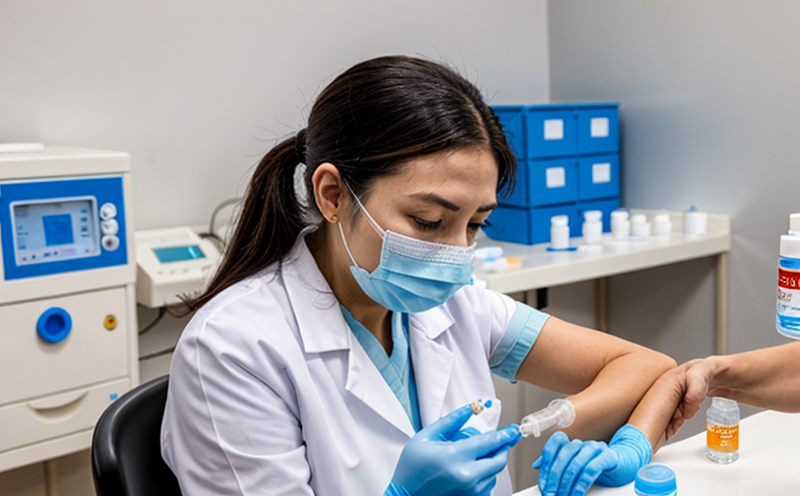USP Potency Assay of Live Attenuated Vaccines
The United States Pharmacopeia (USP) Potency Assay is a critical quality assurance test used to determine the effectiveness of live attenuated vaccines. This assay ensures that each dose meets the required potency levels as defined by USP standards, which are widely recognized and followed in pharmaceutical manufacturing.
Live attenuated vaccines represent an important class of biopharmaceuticals designed to prevent infectious diseases while minimizing the risk of adverse effects associated with live pathogens. These vaccines contain weakened or inactive forms of the pathogen that stimulate an immune response without causing disease. Potency testing is essential for ensuring product consistency, safety, and efficacy.
The potency assay measures the biological activity of the vaccine using standardized methods prescribed by USP guidelines. This test ensures that each batch produced meets predefined specifications, thereby maintaining high standards of quality control throughout manufacturing processes.
During sample preparation, it's crucial to handle live attenuated vaccines with care due to their biological nature and potential risks. Samples must be stored under appropriate conditions until testing begins. Once prepared for analysis, the samples undergo rigorous evaluation using validated techniques such as cell culture or animal models depending on the type of vaccine.
The results from this assay are vital not only for regulatory compliance but also for ensuring patient safety when receiving vaccines. By accurately measuring potency levels, manufacturers can confirm that their products will effectively elicit protective immune responses against targeted pathogens without causing unnecessary harm to recipients.
Accurate and reliable USP potency assays contribute significantly towards establishing trust between healthcare providers, regulators, and the public regarding the efficacy of live attenuated vaccines.
| Aspect | Description |
|---|---|
| Sample Preparation | Handling and storage requirements for live attenuated vaccines. |
| Testing Methodology | Standardized procedures followed to conduct the assay. |
| Data Analysis | Interpretation of results obtained from testing. |
| Aspect | Description |
|---|---|
| Acceptance Criteria | Standards against which potency levels are compared during testing. |
| Reporting Requirements | Details on how results should be documented and communicated. |
Why It Matters
The USP Potency Assay plays a pivotal role in safeguarding public health by ensuring that live attenuated vaccines consistently meet specified potency levels. This is particularly important given the global importance of immunization programs aimed at preventing diseases like measles, polio, and influenza.
For quality managers and compliance officers responsible for overseeing vaccine production, accurate potency testing provides assurance that batches released to market comply with stringent regulatory requirements set forth by bodies such as the FDA and WHO. Ensuring adherence to these standards helps build consumer confidence in pharmaceutical products while reducing the risk of adverse events due to underpotent or overpotent vaccines.
R&D engineers involved in developing new vaccine formulations benefit from precise potency measurements early in their research phase, allowing them to optimize product design for optimal performance and safety. Similarly, procurement professionals can rely on reliable potency test results when sourcing raw materials needed for manufacturing processes.
In summary, the USP Potency Assay serves as a cornerstone of quality assurance efforts within the pharmaceutical industry, supporting both regulatory compliance and clinical efficacy goals associated with live attenuated vaccines.
Scope and Methodology
- Sample collection: Collecting appropriate quantities of vaccine samples according to established protocols.
- Preparation: Handling collected samples carefully during preparation steps.
- Testing: Performing actual assays using approved methods like cell culture or animal models.
- Data interpretation: Analyzing assay results and comparing them against set standards.
| Aspect | Description |
|---|---|
| Sample Collection | Identifying suitable locations for sample collection based on vaccine type. |
| Preparation | Steps involved in preparing samples before testing begins. |
| Testing | Detailed procedures used during the assay process. |
| Data Interpretation | Methods employed to analyze and report findings from tests conducted. |
| Aspect | Description |
|---|---|
| Acceptance Criteria | Standards against which potency levels are evaluated during testing. |
| Reporting Requirements | Guidelines for documenting and communicating results obtained from assays performed. |
Why Choose This Test
- Ensures consistent potency levels across all batches produced.
- Safeguards against potential risks associated with underpotent or overpotent vaccines.
- Supports compliance with regulatory standards set by authoritative bodies like the FDA and WHO.
- Enhances trust between healthcare providers, regulators, and consumers regarding vaccine efficacy.
- Aids in optimizing product design during R&D phases.
- Facilitates reliable sourcing of raw materials used in manufacturing processes.
The USP Potency Assay is indispensable for maintaining high standards of quality assurance within the pharmaceutical industry, especially when dealing with live attenuated vaccines. Its significance cannot be overstated given its direct impact on public health and safety.





